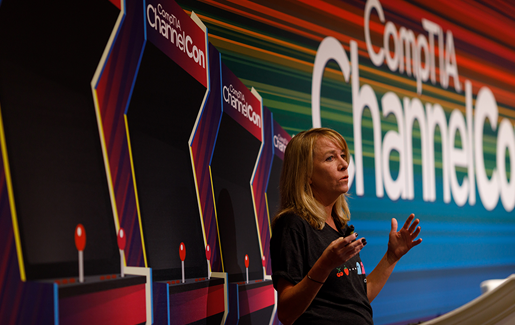 Customers know more—and demand more—regarding their technology purchases and their technology partners, which means solution providers need to have a greater understand of their customers’ experiences in order to remain successful.
Customers know more—and demand more—regarding their technology purchases and their technology partners, which means solution providers need to have a greater understand of their customers’ experiences in order to remain successful.
That knowledge becomes even more critical in the SMB market, which accounts for more than six million businesses in the U.S., alone, and more than $600 billion in IT annual IT spending, said Carolyn April, senior director of industry analysis at CompTIA, who led a presentation at ChannelCon in Las Vegas titled “Tech Habits of SMB Businesses and the New Demands on Customer Experience.”
“Small businesses today are looking to embrace new opportunities in technology and new ways to be more productive, efficient and profitable. They know technology can help them do that,” April said.
Meanwhile, SMBs also are prioritizing customer experiences because they recognize additional value through better and longer-lasting relationships. SMBs said customer experience should be their No. 1 tech spending priority today, according to CompTIA’s SMB Tech Trends research.
Customer Service Can’t Be ‘Cookie Cutter’
HubSpot defines customer experience as “the impression you leave with your customer, resulting in how they think of your brand, across every stage of the customer journey.”
Without that positive experience, many customers will look for alternatives that they perceive provide better service. In fact, one in three consumers will drop a brand they love after just one bad experience, according to PwC. Meanwhile, 89% of companies now compete primarily on the basis of the customer experience they provide, according to Gartner.
Clearly, the door is open for the channel to leverage new CX technologies and initiatives that keep customers happy—and help customers keep their customers happy. But CompTIA’s Customer Experience Trends report indicates that there’s work to be done.
Although 66% of respondents in CompTIA’s CX survey said they provide technical support, less than half have CX activity in other areas, including customer retention/renewal and customer training, indications that CX investments are likely to continue.
Meanwhile, the channel hasn’t fully invested in CX yet either, according to the CompTIA report. While 46% of solution providers said they made minor adjustments for today’s customer experiences in the last year, another 35% said they haven’t made any adjustments for CX, with 27% adding “maybe in the future."
“Operational investments are key to achieving CX goals,” April said. “In the past year, we’ve seen an elevated use of social media platforms for communication with customers, and companies are retraining their customer service staff, but only 40% provide customers with an annual satisfaction email, and the numbers are even lower for other CX tools and tactics.”
SMBs' Tech Investments Paying Dividends
Meanwhile, SMBs of all sizes believe technology is a primary factor in helping them reach strategic business goals, April said, including 73% of medium-sized (100 to 249 employees) companies. Meanwhile, 59% of SMBs are mostly satisfied with company’s use of technology, while only 6% are mostly dissatisfied.
“The good news for solution providers is that most SMBs self-assess that there is some room for improvement regarding their use of technology,” April said. “This opens the door for the channel to help provide more vision and strategy, execution and implementation, and ongoing operations and maintenance.”
The problem is the high fail-rate of SMBs, as only about half of startups survive five years and they see 10%-12% annual turnover from employees. “SMBs are the lifeblood of our economy and create a lot of jobs, but they also destroy a lot of jobs,” April said.
SMBs are more likely than not (53%) to use a managed service provider for their IT, according to CompTIA, but they are more cautious when it comes to emerging technologies, preferring instead to invest in more traditional tech that will provide more predictable outcomes. Just over 40% of respondents said Internet of Things (IOT) software and hardware are impacting their business today, while 41% said IoT hardware is on their radar but hasn’t had an impact yet.
Those using or experimenting with emerging technologies like IoT said that increased productivity is their No. 1 driver, followed by customer demand.
“Overall, SMBs place a high priority on technology and hardware/infrastructure is still important for SMB buyers, while emerging tech will become a bigger opportunity area for channel partners serving that market,” April said

 Add CompTIA to your favorite RSS reader
Add CompTIA to your favorite RSS reader
